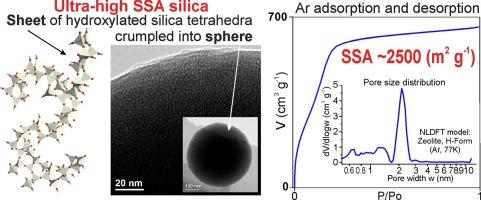具有超高比表面积的新型固体二氧化硅
IF 22
1区 材料科学
Q1 MATERIALS SCIENCE, MULTIDISCIPLINARY
引用次数: 0
摘要
催化、吸附、分离、能量储存和生物医学应用需要高度发达的表面积材料。纳米多孔碳由于其独特的原子薄结构,在无机材料中具有最大的比表面积(SSA),约为3000 m2 g−1。然而,材料的实际效率取决于其官能团数、化学和热稳定性、毒性、成分纯度和亲水性,现有的高ssa材料并不能充分满足这些要求。在这里,我们报道了一种新的固体二氧化硅的合成,其形式是皱褶的硅氧四面体片,其超高(UH) SSA为2500 m2 g−1。湿化学合成制备的材料由水合二氧化硅和有机基团在分子水平上混合组成,它们通过库仑力和范德华力相结合。软脱有机物后,得到的UH - SSA二氧化硅具有复杂的开口结构,其纳米孔径(0.5 - 3nm)被厚度接近硅氧四面体的薄片隔开。所制得的微介孔材料具有高度羟基化的形态,高浓度的表面硅烷醇基稳定了其精致的结构,决定了其亲水性和可调节的表面功能化,同时具有不燃、无毒、生物相容性和环境友好性。这些优点将显著改善应用特性,如高吸附能力、在恶劣条件下的稳定性、高灵敏度和选择性。本文章由计算机程序翻译,如有差异,请以英文原文为准。

Novel solid state of silica with ultra-high specific surface area
Catalysis, sorption, separation, energy storage, and biomedicine applications demand well-developed surface area materials. Nanoporous carbon has the largest specific surface area (SSA) among inorganic materials, of about 3000 m2 g−1, due to its unique atomic-thin structure. However, the practical efficiency of a material depends on its functional group number, chemical and thermal stability, toxicity, composition purity, and hydrophilicity, and the existing high-SSA materials do not sufficiently satisfy these requirements. Here we report on the synthesis of a new solid state of silica in the form of crumpled sheets of silicon-oxygen tetrahedra with an ultra-high (UH) SSA of 2500 m2 g−1. The material prepared by wet chemical synthesis consists of hydrated silica and organic groups mixed at the molecular level, which are associated through the Coulomb and van der Waals forces. After a soft removal of organics, the resulting UH SSA silica has a complex openwork structure with nano-sized pores (0.5–3 nm) separated from each other by the sheet with the thickness close to silicon-oxygen tetrahedron. The obtained micro-mesoporous material has an extremely hydroxylated form, high concentration of surface silanol groups stabilizing the delicate structure and determining its hydrophilicity and tunable surface functionalization, it is also incombustible, non-toxic, biocompatible and environment friendly. These advantageous properties would significantly improve application characteristics, for instance, high adsorption capability, stability in harsh conditions, high sensitivity and selectivity.
求助全文
通过发布文献求助,成功后即可免费获取论文全文。
去求助
来源期刊

Materials Today
工程技术-材料科学:综合
CiteScore
36.30
自引率
1.20%
发文量
237
审稿时长
23 days
期刊介绍:
Materials Today is the leading journal in the Materials Today family, focusing on the latest and most impactful work in the materials science community. With a reputation for excellence in news and reviews, the journal has now expanded its coverage to include original research and aims to be at the forefront of the field.
We welcome comprehensive articles, short communications, and review articles from established leaders in the rapidly evolving fields of materials science and related disciplines. We strive to provide authors with rigorous peer review, fast publication, and maximum exposure for their work. While we only accept the most significant manuscripts, our speedy evaluation process ensures that there are no unnecessary publication delays.
 求助内容:
求助内容: 应助结果提醒方式:
应助结果提醒方式:


